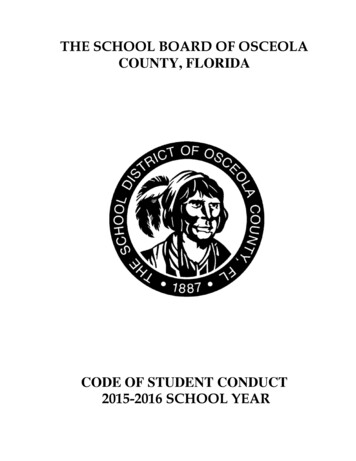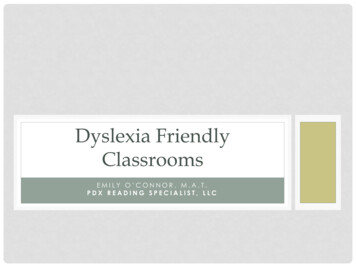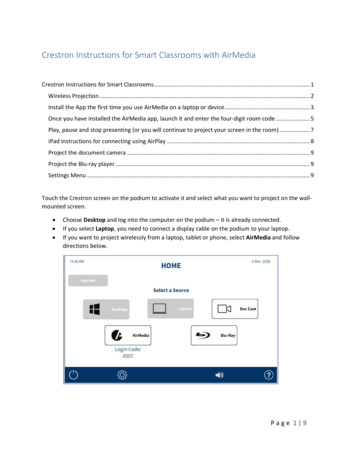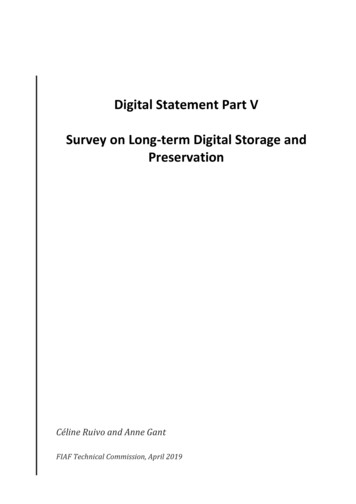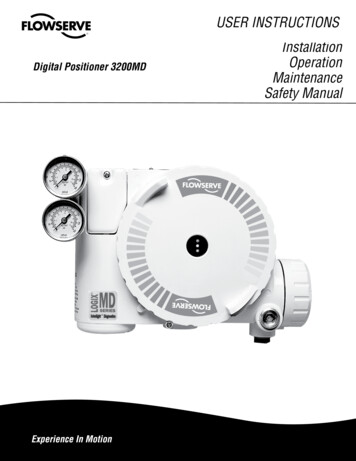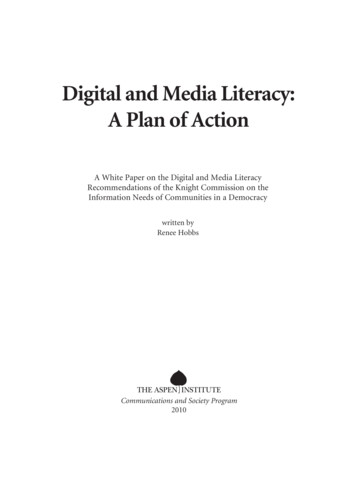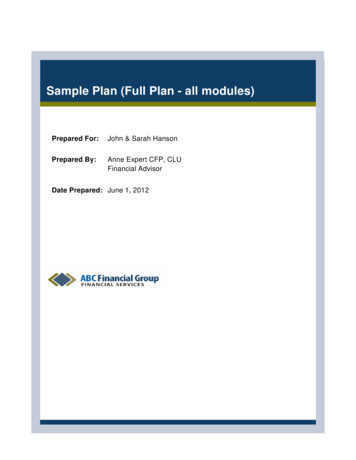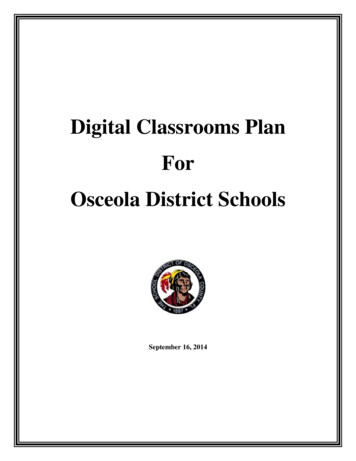
Transcription
Digital Classrooms PlanForOsceola District SchoolsSeptember 16, 2014
TABLE OF CONTENTSPart I.Digital Classrooms Plan – Overview .11.1District Mission and Vision Statements .11.2District Profile .11.3District Team Profile.31.4Planning Process .31.5Multi-Tiered System of Supports (MTSS) .4Part II.Digital Classrooms Plan – Strategy .62.1Needs Analysis.62.A.Student Performance Outcomes – Needs Analysis .62.B.Digital Learning and Technology Infrastructure – Needs Analysis .102.C.Professional Development – Needs Analysis .132.D.Digital Tools – Needs Analysis .162.E.Online Assessments – Needs Analysis .202.2Goals .222.3Strategies .23Part III.Digital Classrooms Plan – Allocation Proposal .253.A.Student Performance Outcomes .253.B.Digital Learning and Technology Infrastructure .253.C.Professional Development .263.D.Digital Tools .273.E.Online Assessments .27Appendix ARace to the Top Professional Development for Digital Learning Grant .28Appendix BCommittee Members .44Appendix CThird-Party Infrastructure Evaluations .46Appendix DMTSS Flow Chart .50
Part I: DIGITAL CLASSROOMS PLAN – OVERVIEW1.1District Mission and Vision StatementsDistrict Vision:The School District of Osceola County will outperform all other districts in the state ofFlorida.District Mission:Education which inspires all to their highest potential.Technology Vision:The School District of Osceola County will provide technology-rich environments as akey to relevant education, encouraging lifelong learning for all students.Technology Mission:Promote the effective use of technology to improve student achievement.1.2District ProfileOsceola County encompasses an area of Central Florida that has undergone significantchange in recent years. The United States Census estimates Osceola County’s populationat 298,504 residents for 2013. Bouts of explosive growth over the last few decades haveresulted in an increase of 177% from the population of 107,728 in 1990. Many factorsand events have shaped the county since its founding in 1887, but the arrival of WaltDisney World surely represents one of the most-defining milestones. These sprawling,nearby theme parks and resorts transformed Osceola County from a small, ruralcommunity with a population of 25,267 in 1970 to the ever-changing community it istoday.Osceola County is a 1,506 square mile area that serves as the south/central boundary ofthe Central Florida greater metropolitan area. Although officially considered suburban innature, an urban area in the northwest quadrant dominates Osceola County’s geography.This area adjoins Polk, Orange, and Lake Counties and includes most of Osceola’spopulation. It encompasses the communities of Poinciana, Buenaventura Lakes,Celebration, and unincorporated areas ranging from Narcoossee and Harmony in thenortheast to Campbell City and Intercession City in the southwest to Deer Run and St.Cloud Manor in the southeast.Not surprisingly, because of the county’s proximity to numerous tourist attractions,scores of county residents work within the hospitality and service fields for minimumwage. Income statistics reflect the low-paying jobs many people hold. Based on the 2012United States Census estimate, the median household income is 44,887, well below thenational median of 53,046. An estimated 16.0% of adults and 26.0% of children ages 517 live below the poverty level. A significant 70.2% of the student population qualifiesfor the free/reduced lunch program. According to the United States Department ofOsceola DCP Page 1
Labor’s Local Area Unemployment Statistics for November 2013, Osceola County'sunemployment rate remains high at 6.6%.One of the most-interesting county characteristics is Osceola’s racial and ethnic diversity.The most-recent racial/ethnic data available (2013-2014 school year) reflects the diversityof the District’s 56,880 students. The distribution of students among the major racegroups is 73% White, 14% Black, 6% American Indian or Alaskan, 3% Asian, and 4%Multiracial. And well over half (57%) of students are part of the Hispanic ethniccategory. The District’s culturally diverse community represents 107 countries andinvolves use of 97 different languages. Accordingly, a significant portion of the studentpopulation (26%) is classified as “English Language Learners” (ELL) in 2013-2014.Overall, in spite of various gains, students’ 2014 Florida Comprehensive AssessmentTest (FCAT) and End of Course (EOC) results show a pattern of achievement thatconsistently falls below state averages. For reading, 56% of the District’s elementaryschool students scored Level III or above, while the state average is 58%. Similarly, 54%of the District’s middle school students and 48% of the District’s high school (grades 9and 10) students scored Level III or above in reading, but the state reports higheraverages of 58% for middle school and 54% for high school. In mathematics, percentagesof the District’s students achieving Level III or greater are 50% for elementary schooland 41% for middle school. Once again, state averages were higher with 59% forelementary school and 52% for middle school. The Spring 2014 Algebra 1 EOCAssessment results indicate that 39% of the District’s high school students passed, whilethe state’s average was 46%. On the science portion of FCAT, 52% of the District’selementary school students scored Level III or above compared to the state average of54%. The District’s percentage for middle school students was 42%, well below the stateaverage of 49%. According to the Spring 2014 Biology EOC Assessment data, the state’saverage of high school students who passed was higher at 58% than the District’s averageof 43%.The District’s post-secondary institution, Technical Education Center Osceola (TECO),works closely with secondary students, offering a variety of courses and certifications(such as CNA, LPN, LEO, EPA, MOUS, A , Network , MCP, and MCSA) to makeOsceola students job-ready upon graduation. The District’s graduation rate was 78.06%for the 2012-2013 school year. Once again, Osceola County has a higher graduation ratethan the state average of 75.6%. Osceola County also continues to have a lower dropoutrate (.8%) than the state average (2%).A tremendous 82.5% of high school completers reported plans to seek further formaleducation in some capacity. Several continuing education opportunities are availablelocally. TECO offers a number of post-secondary, job-preparatory programs for adults;courses support a variety of career choices, and examples include Practical Nursing,Legal Administrative Specialist, Business Computer Programmer, Culinary ArtsPractitioner, Law Enforcement Officer, Automotive Service Technician,Residential/Commercial Electrician, and Residential/Commercial Plumber. AdultLearning Center Osceola (ALCO) offers ESOL, Adult Basic Education, and GEDOsceola DCP Page 2
Preparation and Testing for adults. In addition, Valencia College and Johnson Universityhave campuses in Osceola County.Population increases exert the most influence on Osceola’s situation. County agenciesstruggle to effectively address the growth. The student enrollment is now 56,084, whichequals an increase of 211% from 18,054 in 1990. As of November 2012, the Districtemploys 6,628 staff members (including 160 administrators, 3,480 instructionalpersonnel, and 2,998 professional support personnel). The county has publictransportation, a One-Stop Center, and a number of non-profit community organizationsprepared to offer assistance with food, shelter, employment, medical health, education,and legal services. To meet the needs of students, teachers, and families, the Districtmaintains partnerships (and memorandum agreements) with a myriad of localorganizations. Examples of these collaborating entities include the city/countygovernments and Education Foundation - Osceola County, Community Vision, Inc.,Osceola County Council on Aging, Osceola County Health Department, Park PlaceBehavioral Health Care, Florida Department of Juvenile Justice, and American RedCross.1.3District Team ProfileTitle/RoleInformation TechnologyDistrict ContactCurriculum DistrictContact – ElementaryCurriculum & InstructionCurriculum DistrictContact – Middle SchoolCurriculum & InstructionCurriculum DistrictContact – High SchoolCurriculum & InstructionInstructional DistrictContactFinance District ContactName:Russell -4050Dr. Lissette M. Brizendine brizendl@osceola.k12.fl.us407-870-4849Michael Allenallenmi@osceola.k12.fl.us407-870-1400Dr. Michael R. Akesakesmich@osceola.k12.fl.us407-870-4901Dr. Mel us407-518-2934Todd SeisDistrict Leadership Contact Angela Marino1.4Planning ProcessUpon receipt of the Commissioner’s memorandum concerning the Digital ClassroomsPlan, the District established a committee of 21 stakeholders from which the wide rangeof information needed to develop a plan could be gathered. The names and titles of thecommittee members are listed in Appendix B.Osceola DCP Page 3
The first committee meeting was held on August 18, 2014, with the purpose of reviewingthe requirements, the guidance document, and the template to assign areas ofresponsibility. Subsequently, each group completed the Needs Analysis for theirrespective areas. On August 25, 2014, the committee met to review the Needs Analysisfor each area and make comments and adjustments.On August 28, 2014, the committee met to complete the Goal Setting and Strategysections of the plan.On September 3, 2014, the committee met to review and finalize the plan, includingmaking the determination as to the allocation of funds for the most direct impact ondigital content delivery and online assessments; therefore, improving studentperformance outcomes.The plan was presented to the District Technology Committee on September 5, 2014.This committee is comprised of District staff, school-based administrators, arepresentative for teachers and support staff, and parents.The plan was presented to the Executive Leadership Team for approval on September 8,2014.The plan was presented to the Board for approval on September 16, 2014.1.5Multi-Tiered System of Supports (MTSS)Data-based problem solving is the foundation of the Multi-Tiered System of Support(MTSS) in the District of Osceola County. Data is gathered from various sourcesincluding: state assessments (FSA, FCAT and EOC), quarterly assessments (DistrictPlatform assessments), and progress monitoring (STAR Reading, Math, and EarlyLiteracy). Data analysis takes place at the District and school level. The District allocatesfunds for specific areas after identifying trends. Reading Coaches are allocated for eachschool in the District in order to support Literacy within the core instruction (Tier 1). Inaddition, Reading Coaches also oversee reading and writing interventions for Tier 2 andTier 3. After reviewing tests results, many of the schools have also been allotted MathCoaches and Learning Resources Specialists. Again, the role of these individuals is tosupport Tier 1 instruction and guide and oversee interventions for Tier 2 and Tier 3.Another critical position at each school is the Multi-Tiered System of Support Coach.Currently, there is an individual at each school that is responsible for leading an MTSSTeam. This individual leads the school in the problem-solving process and analyzing datato meet the academic and behavioral needs of all students. The MTSS structure for theDistrict is captured on a flow chart for a unified understanding of the process (AppendixD). Within the District of Osceola County, there are three specific teams to support thisprocess.Osceola DCP Page 4
The first layer of support is at the District level with the District Leadership Team. Thisteam is comprised of: Coordinator of School Improvement and MTSS, AssistantSuperintendents of Curriculum & Instruction, Director of Exceptional Education,Director of Multi-Cultural Education, Director of Student Services, and Supervisor ofPsychological Services. This group meets each month to review the health of the MTSSprocess. The Leadership Team decides on the direction and goals of the Multi-TieredSystems of Support at the District level.The next layer of support is a group of MTSS Regional Leaders. This group includes:Coordinator of School Improvement and MTSS, Supervisor of Psychological Services,four school psychologists, and five school site MTSS Coaches. These individuals meet atleast bi-monthly to review the directional path of the Leadership Team and to support theMTSS coaches within the schools. Each of the Regional Leaders is assigned school sitebased MTSS Coaches to support. These leaders help support the goals of the District andhelp communicate these goals to the individual school sites. This Regional Team meets toproblem solve specific needs for regions and level specific needs. They are also availablefor the school coaches to contact as the need arises.In addition to these two teams, there are three meetings a year held for all MTSSCoaches. The MTSS process is supported at each school with a site based MTSS Coach.The MTSS Coach leads a team that includes an administrator, psychologist, instructionalcoaches, teachers, and other additional staff as needed in the problem solving process.Progress Monitoring is reviewed for all Tiers. This process is ongoing throughout theyear. Tier 1 data is reviewed at least quarterly by the team. Tier 2 data is analyzed on amonthly basis so that changes can be made if student progress is not evident. Tier 3 datais reviewed bi-monthly so that the team can make informed decisions. Recently, a newstudent record system was put into place by the District that allows students’ tieredinformation to be readily available for appropriate identification of tiered specificinformation. This information will be helpful for all instructors to differentiate instructionfor all students at all levels.Although there is a system in place, there is continued support through professionaldevelopment. Over the summer, there was a two day workshop held for each level to lookat school-wide data for academics and behavior. All schools attended with at least fivestaff members. All schools participated with administrative teams. These teams includedadministrators, MTSS coaches, reading and math coaches, school psychologists, andadditional members that the principal of the school selected. The District funded thisevent. The deliverables for this event were the Continuous Improvement ManagementSystem (CIMS) goals and a Tier 1 behavioral plan for all schools. These documents willcontinue to be tweaked throughout the year. Reflective visits will take place by theAssistant Superintendents to check the fidelity of the action plans stated within thesedocuments.The District of Osceola County will continue to utilize the problem solving process toimprove the implementation of the Multi-Tiered Systems of Support.Osceola DCP Page 5
Part II: DIGITAL CLASSROOMS PLAN – STRATEGYSTEP 1 – NEED ANALYSIS:A) Student Performance OutcomesStudent Performance Outcomes (Required)1.2.3.4.5.6.7.8.9.ELA Student AchievementMath Student AchievementScience Student AchievementELA Learning GainsMath Learning GainsELA Learning Gains of the Low 25%Math Learning Gains of the Low 25%Overall, 4-year Graduation RateAcceleration Success 8%55%57%70%68%71%67%80.1%95%Date forTarget 2015**Acceleration success is defined as the percentage of 8th grade students who passed theAlgebra 1 EOC, out of the total number of 8th grade students who took the Algebra 1EOC.The School District of Osceola County has developed long term goals that addresses thefive components of the state provided metrics. In analyzing the AMO data for 2013-2014,the greatest disparity is found between our English Language Learners and Students withDisabilities populations. The math proficiency for the District is at 52%, our ELLstudents are at 35%, while our SWD are at 26%. For reading, the District’s percentproficiency is at 55%, our ELL students are at 34% and our SWD are at 24%. This is anarea of District focus and equitable access to technology is a priority.Increasing student achievement, as well as preparing our students to be College andCareer Ready is the District’s number one goal. Adding CTE courses such as Gamingand Digital Design in several of our high schools will expand the opportunities studentshave to obtain industry certification in a high needs area. One of our identified high needsareas is in the areas of mathematics. The addition of Algebra 1A provides our Level 1students with additional support that integrates a technology component into thecurriculum. This component will aid teachers with progress monitoring, identifyingdeficiency in skills, and providing the remediation of those skills. Establishing a STEMsturdy District is another goal for the upcoming school year. Strengthening the crosscurricular integration between the areas of STEM, summer institutes, as well as providingvertical articulation, from elementary to post-secondary are some initiatives the SchoolDistrict of Osceola County has taken to fortify the areas of science, technology,Osceola DCP Page 6
engineering, and math initiatives. Another digital tool that will aid in student performanceoutcomes is Achieve 3000. This is an online tool that provides Lexile leveled articles forour struggling readers. This year’s goal is to increase the percent of student completingtwo or more articles per week with at least 75% proficiency.In an effort to use technology to increase student achievement, the District will expandthe Bring Your Own Device Network (BYOD). The BYOD initiative will have threelevels of implementation. In the first level, all students can bring devices, but cannotconnect to the student BYOD Network. In the second level, students can bring in devicesand only connect to the student BYOD network from identified locations on the campus.In the third level, students can connect to the student BYOD network from all areas of thecampus. The
The School District of Osceola County will outperform all other districts in the state of Florida. . Technical Education Center Osceola (TECO), works closely with secondary students, offering a variety
